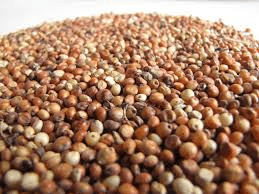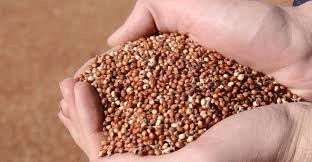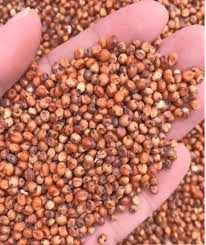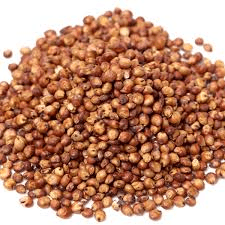Sorghum seeds, produced by the Sorghum bicolor plant, are the reproductive units that develop from fertilized ovaries and are essential for the propagation and cultivation of the crop. These seeds are a significant agricultural product due to their versatility and nutritional value, serving as a staple food, animal feed, and raw material for various industrial applications.
Sorghum seeds are typically small, round, and hard, with a diameter ranging from 3 to 5 millimeters. They are encased in a protective outer layer called the seed coat, which is composed of multiple layers of cells. This seed coat provides protection against physical damage, pathogens, and environmental stresses. The color of the seed coat can vary, ranging from white, yellow, and red to brown or black, depending on the sorghum variety.
Inside the seed coat is the endosperm, which contains the starchy carbohydrates that provide energy for the seed’s germination and initial growth. The endosperm is surrounded by the germ, or embryo, which contains the genetic material necessary for the development of a new plant. The germ is also rich in proteins, fats, and vitamins, contributing to the nutritional value of the seed.
Sorghum seeds are a valuable source of nutrients. They are rich in carbohydrates, providing a substantial energy source for human consumption and animal feed. Sorghum is also high in dietary fiber, which supports digestive health. In addition to carbohydrates and fiber, sorghum seeds contain proteins with a balanced amino acid profile, essential for muscle growth and repair.
Sorghum seeds are a good source of important vitamins and minerals, including B vitamins (such as niacin, riboflavin, and thiamine), iron, magnesium, and phosphorus. These nutrients play vital roles in various physiological functions, including energy metabolism, red blood cell production, and bone health.
Sorghum seeds are used in a variety of culinary applications. They can be cooked and eaten as a whole grain, similar to rice or quinoa. Sorghum flour, made from ground seeds, is used in baking and as a gluten-free alternative to wheat flour. Sorghum is also used to make porridge, bread, and baked goods. In some cultures, sorghum seeds are fermented to produce alcoholic beverages.
Sorghum is grown in diverse climates and soil types, making it an adaptable and resilient crop. It is particularly well-suited for arid and semi-arid regions due to its drought tolerance. This adaptability makes sorghum an important crop for food security in regions where water resources are limited.
The economic importance of sorghum is significant in many developing countries, where it serves as a staple food and a source of income for farmers. In addition to human consumption, sorghum is used as animal feed, particularly for livestock, and in the production of biofuels and other industrial products.
Proper storage of sorghum seeds is crucial for maintaining their viability and ensuring successful germination. Seeds should be stored in a cool, dry place, away from direct sunlight and moisture. Using airtight containers can help protect seeds from pests and environmental conditions that could reduce their quality.
Ongoing research and breeding programs aim to improve sorghum seeds by enhancing their yield, nutritional content, and resistance to pests and diseases. Genetic modification and selective breeding techniques are employed to develop varieties with desirable traits, such as improved drought tolerance, higher grain quality, and better adaptability to different environmental conditions.
Sorghum seeds are a vital component of the Sorghum bicolor plant, playing a key role in its reproduction and cultivation. Their nutritional value, adaptability, and versatility make them an important agricultural product with a wide range of uses. Understanding the characteristics and benefits of sorghum seeds can lead to better cultivation practices, improved food security, and enhanced economic opportunities for farmers.
The Economic Importance and Uses of Sorghum Seeds

1. Food Security: Sorghum seeds are a staple food in many regions, providing essential nutrients and calories. They are particularly important in areas with arid conditions where other crops may not thrive.
2. Animal Feed: Sorghum seeds are used as a high-nutrient feed for livestock, including poultry, cattle, and pigs.
3. Biofuel Production: Sorghum seeds can be processed to produce bioethanol, a renewable source of energy.
4. Human Consumption: The seeds are used in a variety of foods, including porridges, bread, and baked goods. They can also be popped or used as a grain in salads and soups.
5. Traditional Medicine: Sorghum seeds are used in traditional medicine for various health benefits, including digestive health and anti-inflammatory properties.
6. Crop Rotation: Sorghum is used in crop rotation systems to improve soil health and reduce pest and disease pressures.
7. Erosion Control: Sorghum plants can help prevent soil erosion by stabilizing the soil with their root systems.
8. Organic Farming: Sorghum seeds are used in organic farming due to their low need for synthetic inputs and their ability to improve soil fertility.
9. Nutritional Supplements: Sorghum seeds are processed into dietary supplements and health foods due to their high nutrient content, including fiber, protein, and essential minerals.
10. Gluten-Free Products: Sorghum seeds are naturally gluten-free, making them suitable for gluten-free diets and products.
11. Brewing Industry: Sorghum seeds are used in brewing to make traditional beverages and beer, especially in regions where it is a staple crop.
12. Animal Bedding: The husks and by-products from sorghum seeds are used as bedding material for livestock.
13. Biodegradable Materials: Sorghum seed residues can be processed into biodegradable materials and packaging products.
14. Soil Improvement: Sorghum plants add organic matter to the soil when decomposed, enhancing soil structure and fertility.
15. Carbon Sequestration: Sorghum cultivation helps capture carbon dioxide from the atmosphere, contributing to climate change mitigation.
16. Agroforestry Systems: Sorghum can be integrated into agroforestry systems to enhance biodiversity and support sustainable land management.
17. Pest Management: The cultivation of sorghum can help manage pests and diseases by breaking pest cycles in rotation systems.
18. Economic Development: The cultivation and processing of sorghum seeds contribute to local economies, providing jobs and supporting rural development.
Read Also: The Anise Fruits: Economic Importance, Uses, and By-Products
The Products and By-products That Can Be Derived From Sorghum Seeds

1. Edible Grains: Sorghum seeds are used as a staple food grain in various culinary applications.
2. Bioethanol: Produced by fermenting sorghum seeds, used as a renewable energy source.
3. Animal Feed: Processed sorghum seeds are used as feed for livestock.
4. Traditional Beverages: Sorghum seeds are used to make traditional drinks and beers.
5. Gluten-Free Flour: Sorghum seeds can be ground into flour for gluten-free baking and cooking.
6. Nutritional Supplements: Sorghum seeds are processed into dietary supplements for their health benefits.
7. Biodegradable Packaging: Residues from sorghum seeds can be used to create biodegradable packaging materials.
8. Compost: Sorghum seed residues can be composted to produce organic fertilizer.
9. Animal Bedding: Husks and other by-products are used as bedding material for livestock.
10. Natural Dyes: Extracts from sorghum seeds can be used to produce natural dyes for textiles.
11. Industrial Starch: Sorghum seeds contain starch that can be used in various industrial applications.
12. Brewing Ingredients: Sorghum seeds are used in brewing traditional and specialty beverages.
13. Biochar: Sorghum seed residues can be processed into biochar for soil improvement and carbon sequestration.
14. Green Manure: Plant residues, including those from sorghum seeds, can be used as green manure to enhance soil fertility.
15. Textile Fibers: Fibers from sorghum plant parts can be used in textile manufacturing.
16. Pest Repellents: Residues from sorghum seeds can be used to create natural pest repellents.
17. Bioremediation Agents: Sorghum residues can be used in bioremediation products to clean contaminated soils.
Read Also: Dragon Fruits: History, Nutrition, Health Benefits and Growing Guide
Frequently Asked Questions (FAQ’s) About Sorghum Seeds

1. What are sorghum seeds used for?
Sorghum seeds are used for food, animal feed, biofuel production, and in traditional medicine.
2. Can sorghum seeds be used as animal feed?
Yes, sorghum seeds are used as a high-nutrient feed for various livestock.
3. Are sorghum seeds suitable for gluten-free diets?
Yes, sorghum seeds are naturally gluten-free and used in gluten-free products.
4. How do sorghum seeds contribute to soil health?
Sorghum adds organic matter to the soil when decomposed and helps in crop rotation to improve soil health.
5. Can sorghum seeds be used in biofuel production?
Yes, sorghum seeds can be fermented to produce bioethanol, a renewable energy source.
6. Are there any traditional uses of sorghum seeds?
Yes, sorghum seeds are used in traditional medicine and to make traditional beverages and foods.
7. How do sorghum seeds help with erosion control?
Sorghum plants stabilize the soil with their root systems, helping prevent soil erosion.
8. Can sorghum seed residues be used in crafting?
Yes, residues from sorghum seeds can be used in biodegradable materials and packaging products.
9. How do sorghum seeds contribute to carbon sequestration?
Sorghum cultivation helps capture carbon dioxide from the atmosphere, aiding in climate change mitigation.
10. Are sorghum seeds beneficial for organic farming?
Yes, sorghum seeds are used in organic farming due to their low need for synthetic inputs and ability to improve soil fertility.
Read Also: Chicken Brooder House – Complete Chicks Brooding Care Guide

